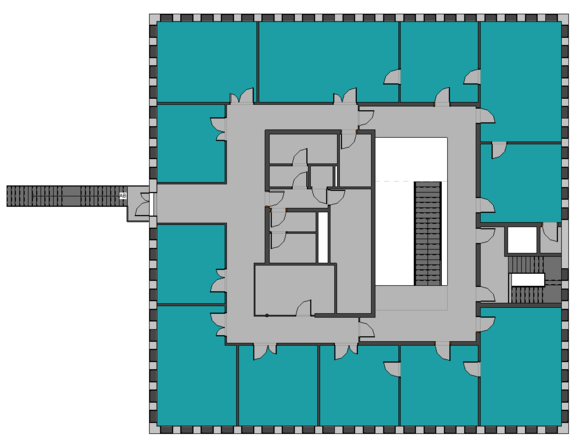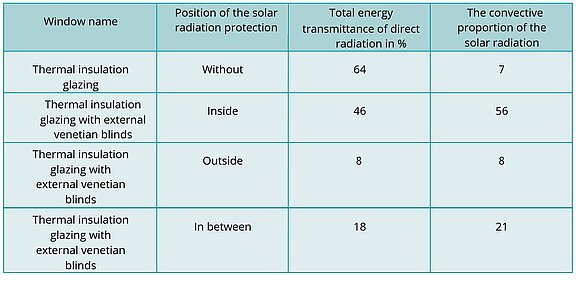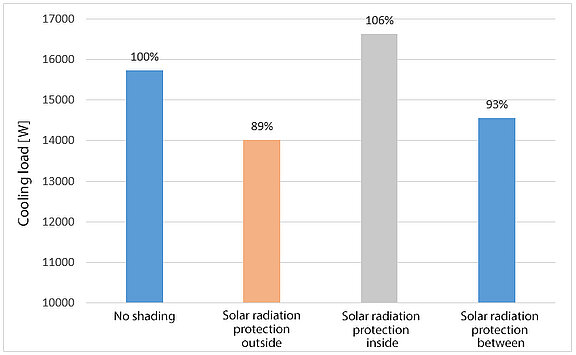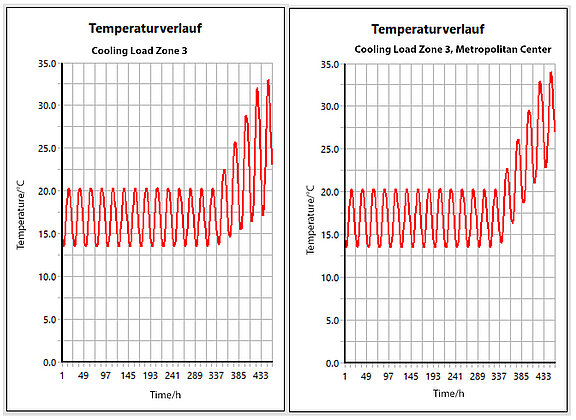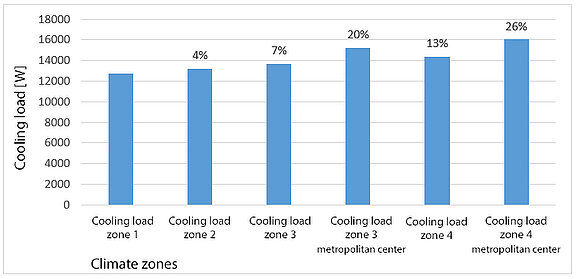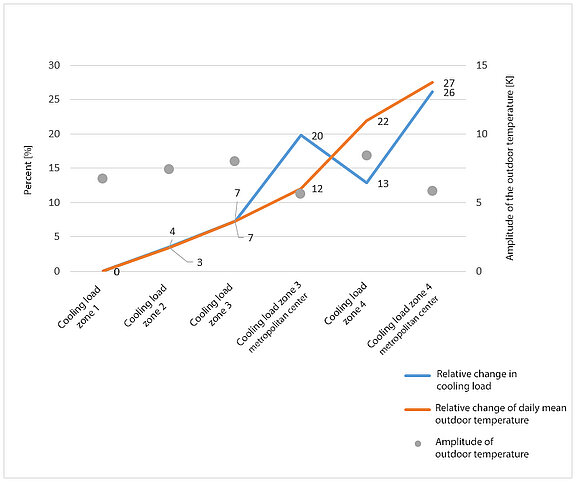
External loads
External cooling loads are the loads which arise due to warmer outside air and solar radiation. The calculation of external loads is decisively affected by the following factors:
- Radiation through transparent exterior components
- Transmission through the wall
- Outside air
“Transparent components” are primarily understood to be windows. A key factor for the external cooling load is the “solar gains” input through the windows. The radiation values depend on the region, the season, the time of day, and atmospheric haze. Solar radiation protection mechanisms can considerably reduce the effects of the influx of radiant heat. The choice of suitable solar radiation protection mechanisms can reduce the investment in building cooling systems and consequently also energy consumption.
Heat storage has an influence on transfer through the walls, because of the dynamic changes in temperature difference between outside and inside. Heat storage is the property of building components to absorb heat and to radiate it again at lower temperatures. The absorbed heat in the building components has a delayed effect in the rooms, depending on how massive the construction is. Buildings with high storage mass ensure that temperature fluctuations in interior spaces are compensated and prevent the heating up of interior spaces above comfort temperatures in summer. Not only does this lead to higher comfort for the indoor climate, but also a reduction in peak load, and consequently also a reduction in energy costs.
Fresh air from the outside renews the air inside buildings. However, it must first be cooled to the desired room temperature. Outside air can be fed in by opening windows and doors, through infiltration, or through mechanical ventilation. The outside temperature is dependent on the location and height of the building. For cooling load, taking city climate into account, the VDI guideline 2078 divides cities in Germany into 4 cooling load zones. The mean daily outside temperature and the amplitude of fluctuation in °C is given for each cooling load zone. In addition, VDI provides for an adjustment to metropolitan centers in climate zones 3 and 4, which leads to an increase in the mean daily temperatures and a smaller amplitude. This results in a reduction in the day/night difference. Cities with populations higher than 100,000, with dense concentrations of buildings and without green spaces are counted as metropolitan centers.
Example project
Using an office building, repeated cooling load calculations are performed with varying parameters to estimate the effect of external loads. In this article three of the variants will be presented and discussed as examples. For the comparison, the second floor is used (Figure 1). When calculating the variants, one parameter each is changed, so as to be able to compare and evaluate the selected influencing factors. The windows of the reference building are the equivalent of thermal insulation glazing. The building is situated in Aachen, so it is in cooling load zone 3 according to the VDI 2078 classification. The interior loads are the same for all variants.
Influence of construction footprint and bulk
In the first planning phase of a newbuild, a final decision on the superstructures on the interior walls has not yet been made. Nevertheless, the designer should compile a cooling load estimate. To demonstrate the influence of the construction bulk of the interior walls on the overall cooling load, first the cooling load for the reference building will be determined. 80 percent of the interior walls in the reference building are lightweight party walls, and 20 percent are supporting concrete walls. In the second comparative calculation all interior walls are defined as solid walls (normal concrete).
The bulk and footprint of the exterior walls and the ceilings here remain unchanged. Figure 2 depicts the cooling loads of the two variants as bar chart and the relative changes. A change to the interior wall construction leads to a reduction of the cooling load of three to six percent. An exception here is April, when the cooling load is relatively low and the massive interior walls absorb the short-lived solar radiation to a greater extent and can radiate it again in the night.
Solar radiation protection influence
Windows that are exposed to the sun for a long time without any shade from neighboring buildings or trees produce a heavy load input in the rooms and should be provided with a solar radiation protection mechanism.
To illustrate this influence, the reference building is calculated with different solar radiation protection mechanisms for the windows (Table 1). The results are depicted in Figure 3.
In cases of shading on the inside, it may be that the short-wave solar input is reduced, but the convective input is higher than for a window without solar radiation protection, as can be seen in Table 1. The slats heat up, and a layer of heat is formed between the inside shading and the window surface, which emits heat into the room like a radiator. This increases the cooling load in the room. It may be that the slats inside prevent the fading of furnishing items through UV protection, but they offer no effective thermal protection function.
On one hand, the shading outside reflects the short-wave solar radiation and thus shades the room. But on the other hand, it emits the absorbed thermal radiation largely to the outside by convection. As such, shading outside is the most effective variant, and in this example it leads to a reduction of the cooling load of 11%. Slats in between likewise reflect direct radiation, but they radiate solar heat to a greater extent on to the window, and thus into the room, than the shading outside. In our example this variant leads to a reduction in cooling load of 7%.
Influence of the cooling load zone and the metropolitan center
The reference building is calculated with constant location coordinates in the four cooling load zones of VDI 2078. The location coordinates are kept the same, to keep the influence of the position of the sun the same. This way the results only reflect the influence of the outside temperature and the influence of the metropolitan center for the cooling load zones 3 and 4. When the metropolitan center is activated the mean daily temperatures of the zone and the temperature difference between day and night decrease. This leads to a reduction in amplitude (see Figure 4).
Table 2 depicts the amplitudes and the mean daily outside temperatures on the design day for the four cooling load zones and for metropolitan centers of zones 3 and 4 in the month of July. The simulated cooling load results are also indicated.
Figure 5 depicts the change in the cooling load peak dependent on the cooling load zones. The cooling load rises with rising cooling load zone, but the metropolitan center of cooling load zone 3 causes a higher rise in the cooling load than the higher temperature in cooling load zone 4.
Figure 6 depicts the percentage increase of the cooling load peak for different cooling load zones, dependent on the outside temperature and amplitude.
The cooling load is proportional to outside temperature; with rising outside temperature the cooling load also rises. Amplitude also affects the cooling load. This effect is evident in the following graphic representation. Compared to cooling load zone 4, the metropolitan center of cooling load zone 3 displays a higher cooling load despite the lower outside temperature. Because of the smaller amplitudes the temperature difference between day and night is smaller, so the building doesn’t cool down as much overnight. This leads to higher cooling loads, despite lower outside temperatures.
Summary
The three views help to illustrate the order of magnitude of the influence of external loads on the result of the cooling load calculation. For selected variants such as storage capacity, solar radiation protectionand cooling load zones, each of the parameters were varied and the effect on the maximum cooling load analyzed.
The changes to storage capacity for the inside separating walls from light to massive leads to a three to six percent reduction of the cooling load. The results show that both the use of an outside solar radiation protection mechansism and the use of slats in between lead to a reduction of the cooling load. With solar radiation protection inside and a high proportion of convection the cooling load can even increase!
For the cooling load zones, not only the outside temperature but also its amplitude has an effect on the cooling load. Activating the “metropolitan center” option gives rise to a smaller amplitude, and a larger cooling load accordingly.
